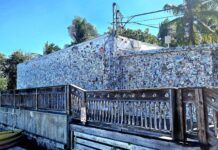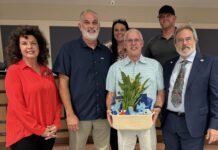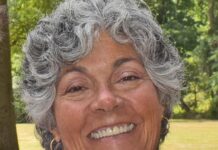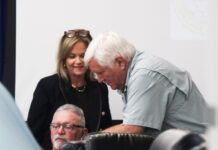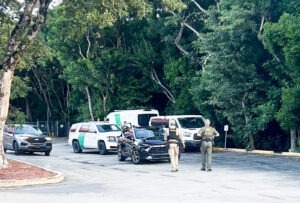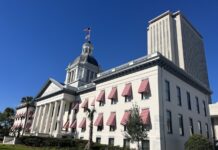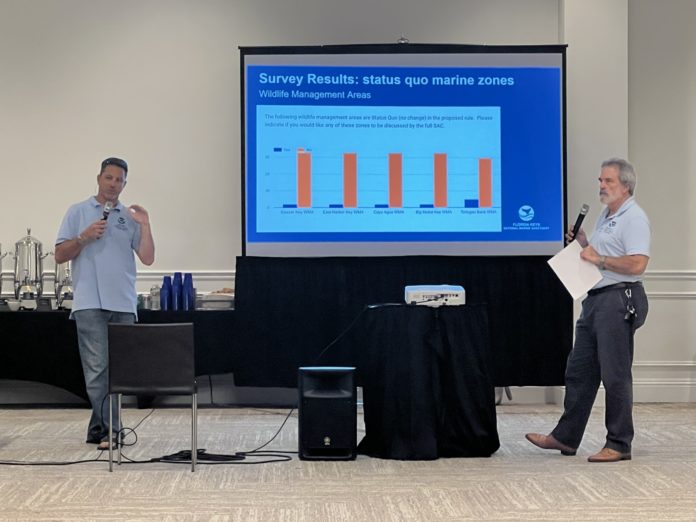
The Florida Keys National Marine Sanctuary Advisory Council (SAC) has a behemoth task looming at its two-day – for now – December meeting: submit a comprehensive recommendation to guide final edits of the sanctuary’s proposed Restoration Blueprint, the first significant changes to sanctuary regulations in more than 20 years. It’s a large enough task that the council spent the majority of its Oct. 18 meeting in Marathon simply discussing the process by which it will create a finished product.
Though the currently proposed Blueprint is open for online public comment at regulations.gov until Wednesday, Oct. 26, Tuesday’s meeting represented the final chance for in-person public comment, the majority of which echoed concerns from the sanctuary’s previous public sessions held throughout the Florida Keys.
Most civil commenters expressed displeasure with specific area closures, boundary expansions, anchoring regulations, changes to fish-feeding operations, enforcement issues for violators and perceived “government overreach.” Others expressed strong support for the sanctuary’s proposed measures, viewing the majority of the proposed Blueprint as a small compromise for continued protection of critical areas in Keys waterways.
“I believe it’s time to give back to the resource and the environment,” said Marathon charter captain Jimmy Gagliardini. “There are a lot of people that are in this room for one reason: they are here to spite government. … They don’t know any of the facts, and they don’t care to. … I don’t see this as a step in the right direction; I see it as a giant leap forward.”
The meeting’s afternoon session served as a trial run for the process SAC chair George Garrett and vice chair Ben Daughtry hope will guide issue-specific discussions in December. Using a previously-completed survey of SAC members’ discussion priorities, the pair identified nearly 30 specific points of interest in the Blueprint, initially tasking members of a smaller “core group” with drafting “support statements” and “issues to consider” as a trial run for a few of them.
Beginning with two areas of the proposed sanctuary boundary expansion – the Tortugas Region and deep photosynthetic coral reef system known as Pulley Ridge – Daughtry polled council members in attendance on their thoughts, adding their support points and concerns to create a comprehensive summary for each region.
With an extensive list of pros and cons from varied stakeholders likely to surround each point of contention, discussion shifted as to how the council would ensure delivery of a comprehensive and digestible product to sanctuary superintendent Sarah Fangman following December’s meeting.
“I want to acknowledge how much work that the members of the core group have done to try to think through, ‘How in the world would we do this?’” said Fangman. “To me, the opportunity of this group to provide your thoughts collectively is powerful, and it’s really hard. … I appreciate you guys testing this concept, and then hopefully committing to doing homework between now and December to help facilitate important conversations and hopefully coming to some conclusions as a body, as much as that’s possible.”
Several suggested methods of online polling and digital collaboration before the council’s next gathering as a way to streamline discussions, in addition to the use of breakout groups to tackle summaries of each regulation change before discussion with the entire council.
Conservation and Environment council member Jerry Lorenz advocated for a weighted polling process by which SAC members could specify their level of support for, or concern with, specific discussion points, rather than a simple majority vote on each regulation change. In doing so, sanctuary staff would be able to easily identify both points of contention and so-called “no-brainers” in the proposed changes.
“The simple answer for me is that you weight this by voting,” he said. “We’re not all going to agree, so this does give the reader the ability to go, ‘Well, the council really favored (that proposal), but they were divided on this one.’”
With the exact process in December still to be determined, Daughtry and Garrett tasked SAC members and alternates with choosing specific regulations for which they wish to draft support and concern statements. The statements generated by council members will inform the direction of December’s final discussion on each topic.
Following December’s meeting, scheduled for Tuesday and Wednesday, Dec. 13-14 at a Marathon location to be determined, the Restoration Blueprint will undergo an extensive 18- to 20-month review by sanctuary staff, including consultation with stakeholder agencies, before a final review at the state and federal level.
More information about the proposed Restoration Blueprint is at https://floridakeys.noaa.gov/blueprint/.



